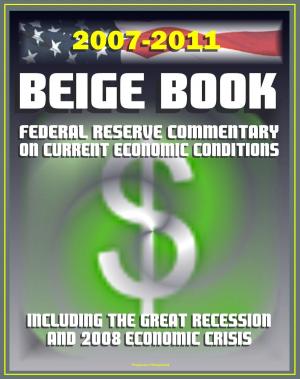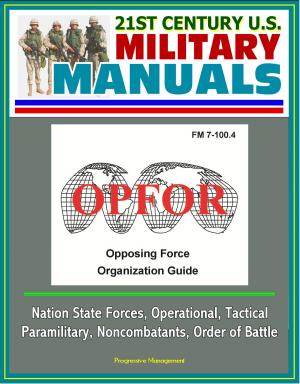The American Military and the Far East: Ninth Military History Symposium - Asia and Asian Military, Objectives, Pacification, Japan Occupation, World War II, Vietnam, MacArthur, Orient Naval Strategy
Nonfiction, History, Military, Vietnam War, Asian, World War II| Author: | Progressive Management | ISBN: | 9781311965042 |
| Publisher: | Progressive Management | Publication: | August 16, 2015 |
| Imprint: | Smashwords Edition | Language: | English |
| Author: | Progressive Management |
| ISBN: | 9781311965042 |
| Publisher: | Progressive Management |
| Publication: | August 16, 2015 |
| Imprint: | Smashwords Edition |
| Language: | English |
Professionally converted for accurate flowing-text e-book format reproduction, this military publication explores in depth America's military involvement in East and Southeast Asia.
The choice of topic for the Ninth Military History Symposium was based on the observation that comparatively little serious historical research has been done on this topic. This seems surprising, since the U.S. has fought four major conflicts in this area since the turn of the century, and has been continuously and deeply involved with Asian affairs since 1941. More often than not, the experience has been frustrating for both Americans and Asians. Consequently, lessons of the American involvement in Asian affairs have seldom been considered relevant or important, at least when compared to American preoccupation with European concerns. American scholars and military professionals have failed to develop a comprehensive understanding of the lessons that might be learned from the experience in Asia. This dearth of scholarly interest and paucity of understanding led naturally to the conclusion that American military involvement in the "Far East" would be a timely and useful symposium topic. One suspects that cultural differences and misunderstanding may partially explain the ambivalence and unwillingness of many Westerners to examine thoroughly the American experience in East Asia. Misperceptions on both sides of the Pacific have played an important role in war and peacetime relationships, and may have discouraged attempts at objective examination of many events. In order to address this problem, and to stimulate further research, a number of scholars were asked to present papers on topics normally outside the scope of the military history symposia series. It is the firm belief of those who organized this symposium that military history transcends matters of guns, battles, and commanders; sociological and cultural considerations can offer valuable aid to the military historian.
Dedication * Preface * Introduction * Harry R. Borowski and Joe C. Dixon * CHAPTER 1: AMERICAN OBJECTIVES AND STRATEGY IN ASIA * Western Perceptions and Asian Realities * Akira Iriye * American Policy and Strategy in East Asia, 1898-1950: The Creation of a Commitment * Roger Dingman * The United States and East Asia, 1945-1960: The Evolution of a Commitment * Norman A. Graebner * Commentary: A Soldier's Viewpoint * Richard G. Stilwell * Commentary: Some Questions About American Policy in East Asia * Frank E. Vandiver * Discussion and Comments * Frank E. Vandiver (Moderator) * CHAPTER 2: AMERICAN PACIFICATION AND OCCUPATION IN ASIA * The Pacification of the Philippines, 1898-1902 * John M. Gates * The Occupation of Japan, 1945-1952 * Ikuhiko Hata * The First Vietnamization: U.S. Advisors in Vietnam, 1956-1960 * Ronald H. Spector * Commentary: The MacArthur Viewpoint * D. Clayton James * Discussion and Comments. * Samuel F. Wells, Jr. (Moderator) * CHAPTER 3: IMPACT OF THE ASIAN EXPERIENCE ON THE AMERICAN MILITARY * The Orient and U.S. Naval Strategy * Paul R. Schratz * The United States Army on the Pacific Frontier, 1899-1939 * Roy K. Flint * The Impact of the Orient on Airpower * John Schlight * Commentary: Marines in East Asia * Edwin H. Simmons * Commentary: Reflections on the Asian Experience * Allan R. Millett * CHAPTER 4: IMPACT OF THE AMERICAN MILITARY ON ASIAN SOCIETIES. * Ironies of the Chinese-American Military Contact * Frank A: Kierman, Jr. * Japanese Perceptions of the A-Bomb Decision * Sadao Asada * The Impact of U.S. Military Presence on the Republic of Korea * C.I. Eugene Kim * Commentary: Perceptions of Power * William W. Whitson * Discussion and Comments. * Joyce C. Lebra (Moderator) * CHAPTER 5: SUMMARY AND CONCLUSION * Summary Remarks * Theodore Ropp * Concluding Remarks * Alvin D. Coox
Professionally converted for accurate flowing-text e-book format reproduction, this military publication explores in depth America's military involvement in East and Southeast Asia.
The choice of topic for the Ninth Military History Symposium was based on the observation that comparatively little serious historical research has been done on this topic. This seems surprising, since the U.S. has fought four major conflicts in this area since the turn of the century, and has been continuously and deeply involved with Asian affairs since 1941. More often than not, the experience has been frustrating for both Americans and Asians. Consequently, lessons of the American involvement in Asian affairs have seldom been considered relevant or important, at least when compared to American preoccupation with European concerns. American scholars and military professionals have failed to develop a comprehensive understanding of the lessons that might be learned from the experience in Asia. This dearth of scholarly interest and paucity of understanding led naturally to the conclusion that American military involvement in the "Far East" would be a timely and useful symposium topic. One suspects that cultural differences and misunderstanding may partially explain the ambivalence and unwillingness of many Westerners to examine thoroughly the American experience in East Asia. Misperceptions on both sides of the Pacific have played an important role in war and peacetime relationships, and may have discouraged attempts at objective examination of many events. In order to address this problem, and to stimulate further research, a number of scholars were asked to present papers on topics normally outside the scope of the military history symposia series. It is the firm belief of those who organized this symposium that military history transcends matters of guns, battles, and commanders; sociological and cultural considerations can offer valuable aid to the military historian.
Dedication * Preface * Introduction * Harry R. Borowski and Joe C. Dixon * CHAPTER 1: AMERICAN OBJECTIVES AND STRATEGY IN ASIA * Western Perceptions and Asian Realities * Akira Iriye * American Policy and Strategy in East Asia, 1898-1950: The Creation of a Commitment * Roger Dingman * The United States and East Asia, 1945-1960: The Evolution of a Commitment * Norman A. Graebner * Commentary: A Soldier's Viewpoint * Richard G. Stilwell * Commentary: Some Questions About American Policy in East Asia * Frank E. Vandiver * Discussion and Comments * Frank E. Vandiver (Moderator) * CHAPTER 2: AMERICAN PACIFICATION AND OCCUPATION IN ASIA * The Pacification of the Philippines, 1898-1902 * John M. Gates * The Occupation of Japan, 1945-1952 * Ikuhiko Hata * The First Vietnamization: U.S. Advisors in Vietnam, 1956-1960 * Ronald H. Spector * Commentary: The MacArthur Viewpoint * D. Clayton James * Discussion and Comments. * Samuel F. Wells, Jr. (Moderator) * CHAPTER 3: IMPACT OF THE ASIAN EXPERIENCE ON THE AMERICAN MILITARY * The Orient and U.S. Naval Strategy * Paul R. Schratz * The United States Army on the Pacific Frontier, 1899-1939 * Roy K. Flint * The Impact of the Orient on Airpower * John Schlight * Commentary: Marines in East Asia * Edwin H. Simmons * Commentary: Reflections on the Asian Experience * Allan R. Millett * CHAPTER 4: IMPACT OF THE AMERICAN MILITARY ON ASIAN SOCIETIES. * Ironies of the Chinese-American Military Contact * Frank A: Kierman, Jr. * Japanese Perceptions of the A-Bomb Decision * Sadao Asada * The Impact of U.S. Military Presence on the Republic of Korea * C.I. Eugene Kim * Commentary: Perceptions of Power * William W. Whitson * Discussion and Comments. * Joyce C. Lebra (Moderator) * CHAPTER 5: SUMMARY AND CONCLUSION * Summary Remarks * Theodore Ropp * Concluding Remarks * Alvin D. Coox















